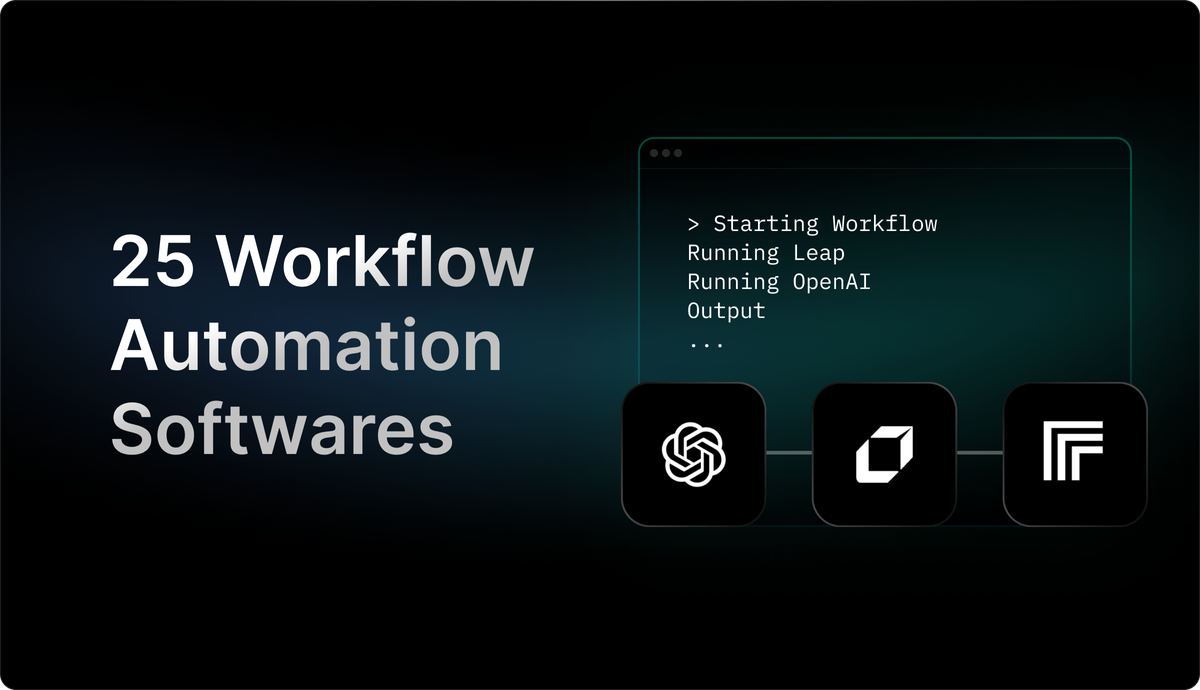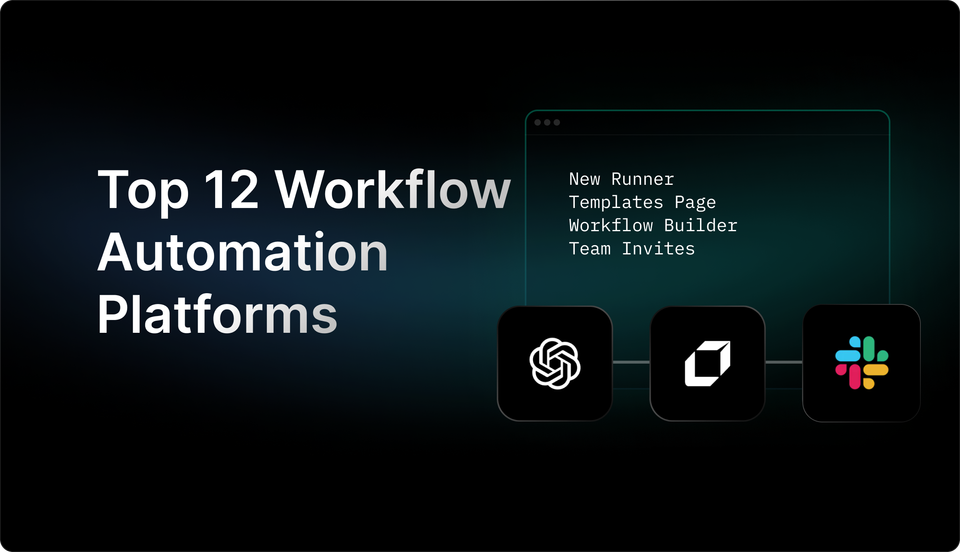25 Best Workflow Automation Software Solutions for 2024
Discover the top workflow automation software solutions for streamlining your processes. Find the perfect fit for your organization today!

Discover the efficiency and productivity boost that a workflow automation platform can bring to your business. Streamline your processes, eliminate bottlenecks, and reduce human error by implementing workflow automation. With this innovative technology, you can automate repetitive tasks, improve collaboration among team members, and ultimately enhance the overall workflow of your organization. Keep reading to learn how workflow automation platform can revolutionize your operations and drive success in today's fast-paced business world.

What is a Workflow Automation Platform?

A workflow automation platform is a digital tool that streamlines and automates business processes and tasks by enabling the creation of automated workflows. These platforms work by allowing users to map out the sequence of steps in a process, define rules and conditions, and automate the execution of these steps based on triggers or events. The core purpose of a workflow automation platform is to enhance efficiency and productivity by reducing manual effort, minimizing errors, and ensuring consistent and compliant process execution.
Key Benefits of Implementing Workflow Automation Software
Improved Communication
Automating workflows enables seamless communication between team members, departments, and systems, ensuring that the right information reaches the right people at the right time.
Increased Efficiency and Productivity
By automating repetitive tasks and eliminating manual bottlenecks, workflow automation software accelerates processes, allowing teams to focus on high-value activities.
Reduced Human Error and Manual Effort
Automation reduces the likelihood of errors caused by manual data entry or processing, leading to higher accuracy and quality in business operations.
Improved Compliance and Consistency
Workflow automation enforces standardized processes, ensuring that tasks are completed according to predefined rules and regulations.
Enhanced Visibility and Control Over Processes:
These platforms offer real-time visibility into workflow progress, bottlenecks, and performance metrics, empowering stakeholders to make informed decisions and adjustments.
Better Resource Allocation and Cost Savings:
By optimizing resource utilization and reducing operational inefficiencies, workflow automation software helps organizations save time and costs.
Streamlined Processes
Automation streamlines complex processes by connecting disparate systems, applications, and data sources, creating a seamless flow of information and tasks.
Common Use Cases Across Different Industries
Marketing
Workflow automation software can streamline lead nurturing, campaign management, and content approval processes, ensuring timely and targeted marketing efforts.
Sales
Automating quote-to-cash, contract management, and order processing workflows can accelerate sales cycles, improve customer satisfaction, and boost revenue.
Customer Service
Workflow automation platforms help automate ticket management, returns and refunds processing, and knowledge base updates, enhancing customer service efficiency and responsiveness.
Human Resources
Automating employee onboarding, leave requests, and performance reviews simplifies HR operations, improves employee experience, and ensures compliance with policies.
Finance and Accounting
Workflow automation software can streamline tasks such as invoice processing, expense reimbursement, and budgeting, enhancing financial accuracy, transparency, and compliance.
IT and Operations
Automating incident management, software deployment, and server monitoring processes improves IT and operational efficiency, reduces downtime, and enhances system reliability.
Healthcare
Workflow automation platforms can optimize patient intake, claims processing, and medical billing workflows, improving patient care, reducing administrative burdens, and ensuring data accuracy.
Manufacturing:
Automation of supply chain management, quality control, and maintenance scheduling processes in manufacturing enhances operational efficiency, reduces costs, and ensures product quality.
Effortlessly Automate Your Tasks with Leap AI Integration
Leap helps you to automate your work with the power of AI. Partnered with Zapier, Vercel, and more, Leap enables you to supercharge your work by allowing you to create custom AI automations. Create sophisticated AI automations with no-code. Connect the tools you love with best-in-class AI text, image, and audio models.
Supercharge your existing tools with seamless AI integrations to OpenAI, Microsoft, and more. From summarizing documents, to voice translation, to AI call transcription, to AI avatar and asset generation, to SEO automation, to even automating the cold email creation and sending process, automate anything with Leap Workflows. The opportunities for automation are endless with Leap workflows.
Try Leap’s AI Workflows tool for free today.

Related Reading
Evaluating Workflow Automation Platforms

A robust workflow automation platform should offer a range of essential features to streamline processes efficiently. These include:
- Visual workflow designer for intuitive workflow creation
- Pre-built templates for quick implementation
- Automated task assignments and notifications for real-time updates
- Integration with existing business applications for seamless data flow
- Reporting and analytics for performance tracking
- Mobile accessibility for on-the-go management
- Role-based access control for security
- Versioning with audit trails for transparency and accountability.
Key Factors to Consider When Choosing a Workflow Automation Solution
When selecting a workflow automation solution, businesses must assess several critical factors to ensure the chosen platform aligns with their needs. Factors to consider include:
- Scalability to accommodate evolving workflow complexities
- Ease of use for quick adoption
- Customization options for tailoring workflows
- Adherence to security and compliance standards
- Vendor support and maintenance for ongoing assistance
- Pricing and deployment models that suit the organization's budget and infrastructure.
- Integration capabilities with existing systems and future compatibility are vital to prevent siloed operations and ensure seamless workflow execution.
Implementation and Integration Requirements for Workflow Automation
Implementing a workflow automation solution entails various considerations to guarantee a smooth transition and successful integration. Businesses should focus on aspects such as:
- Data migration and process mapping to ensure data continuity
- User training and change management for user acceptance
- Integration with legacy systems and third-party applications for a cohesive digital ecosystem
- Workflow testing and validation to identify potential issues proactively
- Ongoing maintenance and support requirements to sustain optimal system performance.
By addressing these implementation and integration aspects strategically, organizations can maximize the benefits of their workflow automation solution and drive operational efficiency.
Streamline Your Workflow with Leap's AI Automation
Leap helps you to automate your work with the power of AI. Partnered with Zapier, Vercel, and more, Leap enables you to supercharge your work by allowing you to create custom AI automations. Create sophisticated AI automations with no-code. Connect the tools you love with best-in-class AI text, image, and audio models.
Supercharge your existing tools with seamless AI integrations to OpenAI, Microsoft, and more. From summarizing documents, to voice translation, to AI call transcription, to AI avatar and asset generation, to SEO automation, to even automating the cold email creation and sending process, automate anything with Leap Workflows. The opportunities for automation are endless with Leap workflows.
Try Leap’s AI Workflows tool for free today.
Top 25 Workflow Automation Software Solutions in 2024

1. Leap - Best Overall
Leap helps you to automate your work with the power of AI. Partnered with Zapier, Vercel, and more, Leap enables you to supercharge your work by allowing you to create custom AI automations. Create sophisticated AI automations with no-code. Connect the tools you love with best-in-class AI text, image, and audio models.
Supercharge your existing tools with seamless AI integrations to OpenAI, Microsoft, and more. From summarizing documents, to voice translation, to AI call transcription, to AI avatar and asset generation, to SEO automation, to even automating the cold email creation and sending process, automate anything with Leap Workflows. The opportunities for automation are endless with Leap workflows.
Try Leap’s AI Workflows tool for free today.
2. Kissflow
Best No-Code Workflow Automation
3. Zapier
Best for Connecting Different Apps
4. Sender
Best Email Marketing Automation Software
5. Pipefy
Best for Process Management
6. Nintex
Best Enterprise Workflow Solution
7. Flokzu
Best for Project Management Teams
8. Zoho Creator
Best Low-Code Application Development
9. ProcessMaker
Best Open Source Option
10. Jira Work Management
Best for Agile Teams
11. airplane
Best for Document Workflows
12. Servelance
Best for IT Service Management
13. ProntoForms
Best for Mobile Workforce Automation
14. Cflow
Best for No-Code Process Automation
15. Onit
Best for Legal Workflows
16. Intellect
Best AI-Powered Workflow Automation
17. Laserfiche
Best for Enterprise Content Management
18. Tallyfy
Best for Repeatable Processes
19. ProcessMate
Best for Financial Services
20. Qntrl
Best for Healthcare Workflows
21. TrackVia
Best Low-Code Process App Platform
22. BlueConic
Best for Customer Data Workflows
23. Hyland's OnBase
Best for Case Management
24. Signavio
Best for Process Mining and Optimization
25. BP Logix
Best Low-Code BPM Suite
Emerging Trends in Workflow Automation for 2024

The rise of AI and machine learning is reshaping the landscape at an unprecedented pace. The integration of AI and machine learning into workflow automation platforms is revolutionizing how businesses streamline their processes, making them more efficient and intelligent. In 2024 and beyond, we can expect AI to continue playing a pivotal role in enhancing workflow automation by enabling predictive analytics, smart decision-making, and cognitive automation.
Impact of AI and Machine Learning on Workflow Automation
AI and machine learning are empowering workflow automation platforms to evolve beyond simple task automation. These technologies are enabling the creation of more sophisticated workflows that can adapt, learn, and optimize themselves over time. By leveraging AI and machine learning algorithms, workflow automation platforms can intelligently orchestrate tasks, predict outcomes, and identify patterns in data, leading to enhanced productivity and efficiency.
Increased Adoption of Low-Code/No-Code Platforms
The increased adoption of low-code/no-code platforms is democratizing workflow automation, allowing non-technical users to create and deploy automated workflows with ease. These platforms offer a visual interface that simplifies the automation process, reducing the reliance on traditional coding skills. As more businesses embrace low-code/no-code platforms, the barrier to entry for implementing workflow automation is lowered, driving widespread adoption across industries.
Integration with Emerging Technologies like AR/VR
Workflow automation platforms are expanding their capabilities by integrating with emerging technologies like Augmented Reality (AR) and Virtual Reality (VR). By incorporating AR/VR functionalities into automation workflows, businesses can enhance collaboration, visualization, and decision-making processes. These integrations enable users to interact with data in immersive ways, improving task execution and overall operational efficiency.
AI-Powered Automation with Leap
Leap helps you to automate your work with the power of AI. Partnered with Zapier, Vercel, and more, Leap enables you to create custom AI automations. Create sophisticated AI automations with no-code. Connect the tools you love with best-in-class AI text, image, and audio models.
Supercharge your existing tools with seamless AI integrations to OpenAI, Microsoft, and more. From summarizing documents, to voice translation, to AI call transcription, to AI avatar and asset generation, to SEO automation, to even automating the cold email creation and sending process, automate anything with Leap Workflows. The opportunities for automation are endless with Leap workflows.
Try Leap’s AI Workflows tool for free today.
Workflow Automation Software Pricing Models

Workflow automation platforms offer different pricing structures, including perpetual and subscription licensing models. Perpetual licensing involves a one-time upfront payment for the software license but may include additional costs for maintenance, support, and upgrades. This model is suitable for businesses with predictable, long-term usage.
On the other hand, subscription licensing follows a recurring payment model, typically monthly or annually, which often includes maintenance, support, and upgrades in the subscription fee. This model provides flexibility and scalability for businesses with dynamic needs.
Pros and Cons of Perpetual Licensing
Pros
- Upfront cost is generally lower than cumulative subscription payments over time.
- Ownership of the software license.
- Predictable costs over the software's lifespan.
Cons
- Additional costs for maintenance, support, and upgrades.
- Might lack the flexibility to adapt to changing business needs.
- Initial investment can be significant.
Pros and Cons of Subscription Licensing
Pros
- Lower initial investment.
- Inclusive of maintenance, support, and upgrades.
- Flexibility to scale up or down based on business requirements.
Cons
- Cumulative costs over time may exceed a one-time perpetual license.
- Dependency on continuous payments.
- Less ownership of the software compared to perpetual licensing.
Understanding Different Pricing Tiers and Packages
Workflow automation software vendors offer various pricing tiers to cater to different business needs. These tiers typically include:
Basic or Entry-Level Packages
- Limited features and functionalities suitable for small businesses or basic automation needs.
- Minimal customization options but cost-effective for starters.
Standard or Mid-Tier Packages
- Expanded features and capabilities for growing businesses.
- More customization options and integrations with third-party tools.
- Suitable for moderate workflow complexities.
Advanced or Enterprise-Level Packages
- Comprehensive features for large enterprises with complex automation requirements.
- Advanced customization and integration capabilities.
- Enhanced security and compliance features.
Add-On Modules or Premium Features
- Additional modules or features that can be added to existing packages for specific needs.
- Specialized functionalities like advanced reporting, AI integrations, or industry-specific tools.
Revolutionizing Workflows with AI-Powered Automation
Leap helps you automate your work with the power of AI. Partnered with Zapier, Vercel, and more, Leap enables you to supercharge your work by allowing you to create custom AI automations. Create sophisticated AI automations with no-code.
Connect the tools you love with best-in-class AI text, image, and audio models. Supercharge your existing tools with seamless AI integrations to OpenAI, Microsoft, and more. From summarizing documents to AI call transcription, automate anything with Leap Workflows.
Try Leap’s AI Workflows tool for free today.
Related Reading
- Accounts Payable Workflow Automation
- Business Automation Workflow
- Crm Workflow Automation
- Document Workflow Automation
- Education Workflow Automation
- Email Workflow Automation
- Enterprise Workflow Automation
- Hr Workflow Automation
- Intelligent Workflow Automation
- Marketing Automation Workflow Examples
- Legal Workflow Automation
- Workflow Automation Vs Rpa
- Small Business Workflow Automation
- Workflow Process Automation
- Ai Workflow Automation
How to Measure ROI from Workflow Automation

Quantifying the benefits and costs of implementing a workflow automation platform is crucial for justifying the investment, tracking progress, and identifying areas for improvement. Key performance indicators (KPIs) play a vital role in this calculation:
Process Cycle Time Reduction
Measuring the time taken to complete a process from start to finish before and after automation can showcase the efficiency gained.
Cost Savings from Increased Efficiency
Comparing the costs associated with manual processes versus automated workflows helps in understanding the financial impact.
Error Rate Reduction
Tracking the number of errors or rework required due to manual processes against automated ones demonstrates the improvement in accuracy.
Customer Satisfaction and Response Time Improvements
Monitoring customer feedback and response times before and after automation aids in gauging the impact on customer experience.
Employee Productivity Gains
Evaluating the productivity levels of employees handling automated tasks versus manual tasks unveils the gains in efficiency.
Compliance and Risk Mitigation Metrics
Assessing how automation helps in maintaining compliance and reducing risks within processes is crucial for regulated industries.
Establishing a Baseline for Workflow Automation
Before diving into workflow automation, establishing a baseline is essential. This baseline should capture the current state of processes, resource utilization, and associated costs. It provides a reference point for improvement and helps in tracking progress over time. Monitoring and comparing the KPIs against this baseline periodically allows for measuring the impact and success of workflow automation accurately.
Enhancing Workflow Efficiency with AI-Powered Automation
Leap helps you to automate your work with the power of AI. Partnered with Zapier, Vercel, and more, Leap enables you to supercharge your work by allowing you to create custom AI automations. Create sophisticated AI automations with no-code. Connect the tools you love with best-in-class AI text, image, and audio models.
Supercharge your existing tools with seamless AI integrations to OpenAI, Microsoft, and more. From summarizing documents, to voice translation, to AI call transcription, to AI avatar and asset generation, to SEO automation, to even automating the cold email creation and sending process, automate anything with Leap Workflows. The opportunities for automation are endless with Leap workflows.
Try Leap’s AI Workflows tool for free today.
Create Game Changing Automations Today With Leap’s AI Workflows
Leap is a cutting-edge workflow automation platform that harnesses the power of artificial intelligence to streamline and enhance your work processes. By partnering with industry leaders like Zapier and Vercel, Leap empowers users to create custom AI automations without the need for complex coding.
Seamless Integration of AI Models
With Leap, you can seamlessly integrate best-in-class AI text, image, and audio models into your workflows. Whether you need to summarize documents, translate voice messages, transcribe calls, or generate AI avatars and assets, Leap has you covered. By connecting to OpenAI, Microsoft, and other top AI providers, Leap ensures that you have access to the latest and most advanced AI technologies.
Endless Possibilities for Automation
The versatility of Leap Workflows knows no bounds. From automating SEO tasks to streamlining cold email creation and sending processes, Leap enables you to automate virtually any task or process. With Leap, you can unlock a world of possibilities for automation, saving time and increasing productivity across your organization.
Experience the Power of Leap for Free
Ready to supercharge your work with AI automation? Try Leap's AI Workflows tool for free today and discover how you can revolutionize the way you work.
With Leap, the future of automation is at your fingertips.
Related Reading
- Best Workflow Automation Software
- Low Code Workflow Automation
- Legal Workflow Automation Software
- Clickup Alternatives
- Hubspot Workflow
- Pipedream Alternatives
- No Code Workflow Automation Platform
- Jira Automation
- Pipedrive Alternatives
- Sharepoint Workflow Automation
- Pipedrive Workflow Automation Examples
- Workflow Automation Platform
- Zapier Alternatives
- Workflow Automation Tools




